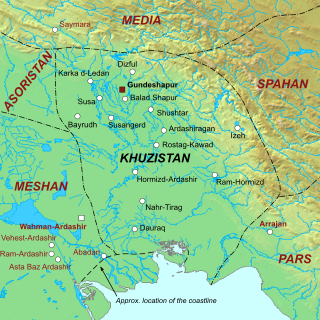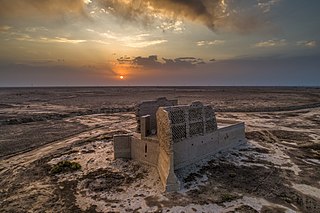Related Research Articles

The Muslim conquest of Persia, also called the Muslim conquest of Iran, the Arab conquest of Persia, or the Arab conquest of Iran, was a major military campaign undertaken by the Rashidun Caliphate between 632 and 654. As part of the early Muslim conquests, which had begun under Muhammad in 622, it led to the fall of the Sasanian Empire and the eventual decline of Zoroastrianism, which had been predominant throughout Persia as the nation's official religion. The persecution of Zoroastrians by the early Muslims during and after this conflict prompted many of them to flee eastward to India, where they were granted refuge by various kings.

Greater Khorasan is a historical eastern region in the Iranian Plateau in West and Central Asia that encompasses western and northern Afghanistan, northeastern Iran, the eastern halves of Turkmenistan and Uzbekistan, western Tajikistan, and portions of Kyrgyzstan and Kazakhstan.
Yazid ibn al-Muhallab al-Azdi was a commander and statesman for the Umayyad Caliphate in Iraq and Khurasan in the early 8th century. In 720, he led the last of a series of wide scale Iraqi rebellions against the Umayyads.

The Battle of Nahavand, also spelled Nihavand or Nahawand, was fought in 642 between the Rashidun Muslim forces under caliph Umar and Sasanian Persian armies under King Yazdegerd III. Yazdegerd escaped to the Merv area, but was unable to raise another substantial army. It was a victory for the Rashidun Caliphate and the Persians consequently lost the surrounding cities including Spahan (Isfahan).

The Muslim conquest of Khuzestan took place from 637/8 to 642, and ended with the acquisition of the rich Khuzestan Province by the Rashidun Caliphate.

Sistān, also known as Sakastān and Sijistan, is a historical region in present-day south-western Afghanistan, south-eastern Iran and extending across the borders of south-western Pakistan. Mostly corresponding to the then Achaemenid region of Drangiana and extending southwards of the Helmand River not far off from the city of Alexandria in Arachosia. Largely desert, the region is bisected by the Helmand River, the largest river in Afghanistan, which empties into the Hamun Lake that forms part of the border between Iran and Afghanistan.

The Aswārān, also spelled Asbārān and Savaran, was a cavalry force that formed the backbone of the army of the Sasanian Empire. They were provided by the aristocracy, were heavily armored, and ranged from archers to cataphracts.

Hormuzan was a Persian aristocrat who served as the governor of Khuzestan, and was one of the Sasanian military officers at the Battle of al-Qādisiyyah. He was later taken prisoner by the Muslims after the fall of Shushtar in 642. Two years later, he was accused of the assassination of the Rashidun caliph Umar, and was killed by Ubayd Allah, the deceased caliph's son.

The Battle of Spahan was fought between the Rashidun Caliphate and the Sasanian Empire in 642. The Arabs were victorious during the battle, where they reportedly killed the Mihran commander Shahrvaraz Jadhuyih. After the battle, the Arabs made peace with Fadhusfan, the governor of the city. According to Abu No'aym, many people were killed or enslaved after the conquest and the settlement pattern of the region changed. Isfahan capitulated by 644 after a few failed revolts and treaties for paying taxes and tributes in exchange for military protection were drawn up.

The Arab conquest of Pars took place from 638/9 to 650/1, and ended with subjugation of the Sasanian province of Pars, also known as Fars or Persis, to the Rashidun Caliphate under Umar.

The siege of Shushtar was fought from 641 to 642 between the Sasanian Empire and the invading Arab Muslims of the Rashidun Caliphate. Shushtar was an ancient strong stronghold in Khuzestan, and was attacked by the Arabs under their commander Abu Musa Ashaari. Although the city managed to resist the Arabs, the Sasanians later faced desertion, which resulted in the Arabs capturing the city and capturing its commander, Hormuzan.

The Muslim conquest of Khorasan, or Arab conquest of Khorasan, was the last phase of the heavy war between the Arab Rashidun caliphate against the Sasanid Empire.
Rabi ibn Ziyad al-Harithi was an Arab military leader, who served the Rashidun and Umayyad Caliphates.
Siyah, known in Arabic sources as Siyah al-Uswari was the commander of a faction of the Sasanian asbaran unit, but later defected to the Rashidun Caliphate, where he continued serving as the commander of the asbaran.
Firuz Husayn was an Iranian aristocrat, who was a key figure in the rebellion of Abd al-Rahman ibn Muhammad ibn al-Ash'ath, which lasted from 700 to 703.
Shiruya al-Uswari was an Iranian nobleman, who was part of the Sasanian asvaran unit, but later defected together with a faction of the unit to the Rashidun Caliphate, where the unit became known as the Asawira. He settled in Basra, and married a Sasanian princess called Marjana, whom he built a palace for on a canal in Basra

Pars was a Sasanian province in Late Antiquity, which almost corresponded to the present-day province of Fars. The province bordered Khuzestan in the west, Kirman in the east, Spahan in the north, and Mazun in the south.
Al-Abnāʾ was a term that was used in South Arabia to refer to people whose lineage was paternally Iranian and maternally Arab. They represented a distinct community that had come into existence following the end of the Aksumite–Persian wars in the 6th century, when Iranian soldiers began intermarrying with Arab women in Sanaa and throughout Yemen. These couples' offspring and their descendants held an ethnic and cultural identity that was influenced by their mixed heritage from the Sasanian Empire and the Himyarite Kingdom, though they eventually assimilated into the society of the latter. Following the rise of Muhammad in the 7th century, most of the al-Abnāʾ community adopted Islam and took part in the early Muslim conquests, including the Muslim conquest of Iran.

ʿAbd Allāh ibn Khāzim al-Sulamī was the Umayyad governor of Khurasan between 662 and 665 and again in late 683, before becoming the nominal Zubayrid governor of the same province between 684 and his death.
Zuṭṭ is an Arabicised form of Jat. Originally inhabitants of lower Indus Valley, Jats were present in Mesopotamia from the 5th century AD since the times of the Sasanian Empire, although their main migration occurred after the establishment of Umayyad Caliphate. They were one of the prominent ethnic groups in lower Iraq during the Islamic Golden Age, supplying mercenary soldiers to the Muslim states. Their mention fades from Arab chronicles after the 11th century.
References
- 1 2 3 4 5 Bosworth 1987, pp. 706–707.
- ↑ "Welcome to Encyclopaedia Iranica".
- ↑ Pourshariati 2008, p. 240.
- ↑ Zakeri 1995, p. 335.